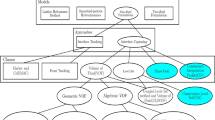Abstract
PIV measurements near a wall are generally difficult due to low seeding density, low velocity, high velocity gradient, and strong reflections. Such problems are often compounded by curved boundaries, which are commonly found in many industrial and medical applications. To systematically solve these problems, this paper presents two novel techniques for near-wall measurement, together named Interfacial PIV, which extracts both wall-shear gradient and near-wall tangential velocity profiles at one-pixel resolution. To deal with curved walls, image strips at a curved wall are stretched into rectangles by means of conformal transformation. To extract the maximal spatial information on the near-wall tangential velocity field, a novel 1D correlation function is performed on each horizontal pixel line of the transformed image template to form a “correlation stack”. This 1D correlation function requires that the wall-normal displacement component of the particles be smaller than the particle image diameter in order to produce a correlation signal. Within the image regions satisfying this condition, the correlation function yields peaks that form a tangential velocity profile. To determine this profile robustly, we propose to integrate gradients of tangential velocity outward from the wall, wherein the gradient at each wall-normal position is measured by fitting a straight line to the correlation peaks. The capability of Interfacial PIV was validated against Particle Image Distortion using synthetic image pairs generated from a DNS velocity field over a sinusoidal bed. Different velocity measurement schemes performed on the same correlation stacks were also demonstrated. The results suggest that Interfacial PIV using line fitting and gradient integration provides the best accuracy of all cases in the measurements of velocity gradient and velocity profile near wall surfaces.











Similar content being viewed by others
References
Buchmann NA, Nguyen CV, Wells JC, Jermy M (2008) In-vitro wall-shear stress measurements using interfacial particle image velocimetry (IPIV). In: 14th International symposium on applications of laser techniques to fluid mechanics, Lisbon, 07–10 July
Buchmann NA, Jermy MC, Nguyen CV (2009) Experimental investigation of carotid artery haemodynamics in an anatomically realistic model. Int J Exp Comput Biomech 1(2):172–192
Denham CR (2000) SeaGrid orthogonal grid maker for Matlab. Woods Hole Science Center, U.S. Geological Survey. http://woodshole.er.usgs.gov/operations/modeling/seagrid/
Gui L, Merzkirch W, Fei R (2000) A digital mask technique for reducing the bias error of the correlation-based PIV interrogation algorithm. Exp Fluids 29(1):30–35
Gui L, Longo J, Stern F (2001) Biases of PIV measurement of turbulent flow and the masked correlation-based interrogation algorithm. Exp Fluids 30:27–35
Hochareon MB, Fontaine A (2004) Wall-shear-rate estimation within the 50cc Penn State artificial heart using particle image velocimetry. J Biomech Eng 126:430–437
Huang HT, Fiedler HE, Wang JJ (1993) Limitation and Improvement of PIV. Exp Fluids 15:263–273
Ives DD, Zacharias RM (1987) Conformal mapping and orthogonal grid generation. AIAA/SAE/ASME/ASEE 23rd joint propulsion conference, Paper No. 87-2057, San Diego
Lecordier B, Westerweel J (2004) The EUROPIV synthetic image generator (S.I.G.). In: Particle image velocimetry: recent improvements. Proceedings of the EUROPIV 2 workshop held in Zaragoza, March 31 April 1, 2003. Springer, Heidelberg
Marr D, Hildreth E (1980) Theory of edge detection. In: Proceedings of the Royal Society of London, Series B, Biological Sciences 2007, pp 187–217
Nakayama A, Sakio K (2002) Simulation of flows over wavy rough boundaries. Center for Turbulent Research, Annual Research Briefs: pp 313–324
Nguyen TD (2007) Development of Stereo PIV: application to turbulent flow over a backward-facing step. Masters thesis, Ritsumeikan University, Shiga
Nguyen CV, Wells JC (2006a) Development of PIV/interface gradiometry to handle low tracer density and curved walls. In: Proceedings of FEDSM2006 European fluids engineering summer meeting, Miami
Nguyen CV, Wells JC (2006b) Direct measurement of fluid velocity gradients at a wall by PIV image processing with stereo reconstruction. J Vis 45:5–27; adapted from Nguyen CV, Phan NMT, Wells JC (2004) Proceedings of international conference on advanced optical diagnostics in fluids, solids and combustion, Tokyo
Nguyen CV, Nguyen TD, Wells JC (2006) Sensitivity of PIV/interface gradiometry to estimated wall position. J Vis Soc Jpn 26(2):203–206
Nobach H, Damaschke N, Tropea C (2005) High-precision sub-pixel interpolation in particle image velocimetry image processing. Exp Fluids 39:299–304
Theunissen R, Scarano F, Riethmuller ML (2008) On improvement of PIV image interrogation near stationary interfaces, Exp Fluids (online)
Wereley ST, Meinhart CD (2001) Second-order accurate particle image velocimetry. Exp Fluids 31(3):258–268
Westerweel J, Geelhoed P, Lindken R (2004) Single-pixel resolution ensemble correlation for micro-PIV applications. Exp Fluids 37:375–384
Wilkin J, Hedström KS (1998) User’s manual for an orthogonal curvilinear grid-generation package. Institute of Marine and Coastal Sciences, Rutgers University http://www.marine.rutgers.edu/po/tools/gridpak/grid_manual.ps.gz
Yokojima S (2002) Modeling and simulation of turbulent open-channel flows emphasizing free-surface effects. PhD thesis, Kobe University, Kobe
Acknowledgments
The first author would like to express appreciation to Dr. Frédéric Plourde, Laboratoire d’Etudes Thermiques—ENSMA, Poitiers, France, for his challenging question about how to deal with curved walls. We also express our special thanks to Nicolas Buchmann, Department of Mechanical Engineering, University of Canterbury, New Zealand, for his valuable discussion on our technique. We acknowledge Charles Denham’s generosity for making SeaGrid toolbox freely available.
Author information
Authors and Affiliations
Corresponding author
Rights and permissions
About this article
Cite this article
Nguyen, C.V., Nguyen, T.D., Wells, J.C. et al. Interfacial PIV to resolve flows in the vicinity of curved surfaces. Exp Fluids 48, 577–587 (2010). https://doi.org/10.1007/s00348-010-0824-1
Received:
Revised:
Accepted:
Published:
Issue Date:
DOI: https://doi.org/10.1007/s00348-010-0824-1




